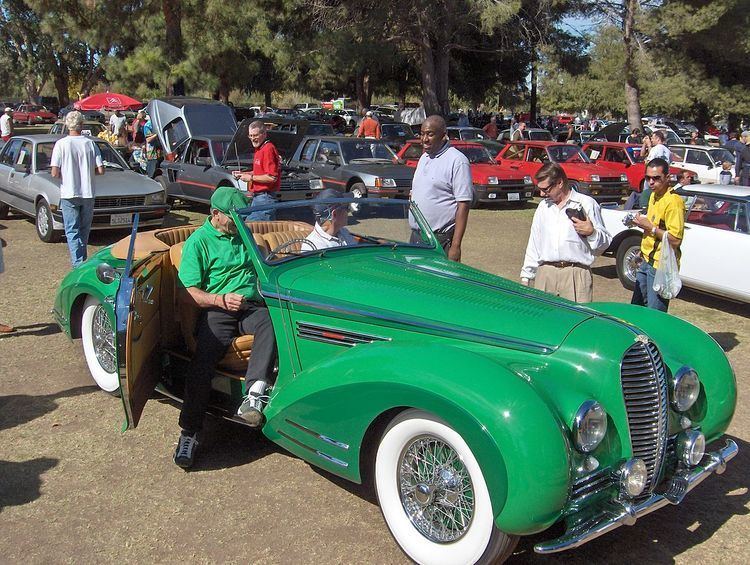 | ||
A "suicide door" is the slang term for an automobile door hinged at its rear rather than the front. Such doors were originally used on horse-drawn carriages, but are rarely found on modern vehicles due primarily to safety concerns.
Contents
Popularized in the custom car trade, the term is avoided by major automobile manufacturers in favor of alternatives such as "coach doors" (Rolls-Royce), "FlexDoors" (Opel), "freestyle doors" (Mazda), "rear access doors" (Saturn), and "rear-hinged doors" (preferred technical term).
History
Suicide doors were common on cars manufactured in the first half of the 20th century. The nickname is mainly due to the design's propensity to seriously injure anyone exiting or entering the offside of the car if the door is hit by a passing vehicle. Also, in the era before seat belts, the accidental opening of such doors meant that there was a greater risk of falling out of the vehicle compared to front-hinged doors, where airflow pushed the doors closed rather than opening them further. Suicide doors were especially popular with mobsters in the gangster era of the 1930s, supposedly due to the ease of pushing passengers out of moving vehicles, according to Dave Brownell, the former editor of Hemmings Motor News.
After World War II, the use of suicide doors was mostly limited to rear doors of four-door sedans. The best-known use of suicide doors on post-World War II American automobiles was the Lincoln Continental 4 door convertibles and sedans (1961–1969) and Ford Thunderbird 1967–1971 four-door sedans. The British Rover P4 cars also used rear suicide doors until their demise in 1964.
Modern use
Due to increasing safety concerns, the last mass-produced car model with independently opening suicide doors sold in the United States was the Ford Thunderbird four-door sedan from 1967 to 1971. Similarly, the last mass-produced pickup truck with such doors was the Toyota Tundra from 2000 to 2002. In 2003, the new Rolls-Royce Phantom (sold in the United Kingdom) reintroduced independent suicide doors in luxury vehicle applications. Other luxury models with classic suicide doors include the Spyker D8 and the Rolls-Royce Phantom Drophead Coupe four-seat convertible. However, the most recent mass-produced model with such doors has been the Rolls-Royce Phantom Series II introduced in 2012.
In recent years, rear suicide doors, that cannot be opened until the regular front doors are opened, have been appearing on a number of vehicles, including extended-cab pickup trucks, the Saturn SC, the Saturn Ion QuadCoupe, the Honda Element, the Toyota FJ Cruiser, the BMW i3 and the Mazda RX-8.
Rear passenger suicide doors had long been used on Austin FX4 hackney carriages. Their successor, the TX1, lacks them.
Several concept cars have featured suicide doors, such as the Lincoln C, a hatchback with no B-pillar and rear suicide doors, or the Carbon Motors Corporation E7, a police car with rear suicide doors designed to aid officers getting handcuffed passengers in and out of the back seat. The Kia Naimo, an electric concept car, also has rear suicide doors.
Other car manufacturers which have produced models with suicide doors include Citroën, Lancia, Opel, Panhard, Rover, Saab, Saturn, Škoda, and Volkswagen.
Advantages
Rear-hinged doors make entering and exiting a vehicle easier, allowing a passenger to enter by turning to sit and exit by stepping forward and out. In combination with traditional front doors, they allow chauffeurs easier access to the rear door. In Austin FX4 taxis, drivers were able to reach the rear door handle through the driver's window without getting out of the vehicle.
Additionally, rear-hinged doors also allow a better position for a person installing a child seat into the back seat of a vehicle than conventional doors, while being simpler and cheaper to build than the sliding doors commonly used on MPVs. However, the most recent MPV with such doors has been the Opel Meriva B introduced in 2010.
Disadvantages
When front doors are directly adjacent to rear suicide doors, exiting and entering the vehicle can be awkward if people try to use the front and back doors at the same time.
There are also a number of safety hazards:
In recent years, car companies have addressed these hazards with such safety features as seat belts, and locks requiring front-hinged doors be open before permitting rear-hinged doors to open.
